Y2 Cognitive & Social Psychology: Conformity, Theories & Social Work
VerifiedAdded on 2023/06/15
|9
|2124
|488
Report
AI Summary
This report provides a comprehensive overview of conformity within the realm of social psychology. It begins by defining conformity as the act of aligning one's behavior with others, distinguishing between informational and normative conformity. The report then delves into key theories such as social comparison theory, which explains how individuals evaluate themselves by comparing to others, and social influence theory, which examines the balance between self-interest and external pressures. Positive and negative aspects of conformity are discussed, highlighting its role in group cohesion and potential drawbacks when it suppresses individual expression. The report also explores the implications of conformity for social workers, considering how it can both facilitate support for vulnerable individuals and potentially lead to misconceptions within professional settings. The report concludes by emphasizing that while conformity can foster a sense of belonging, it is crucial to maintain individuality and critical thinking, acknowledging the complexities of determining whether conformity is ultimately beneficial or detrimental.
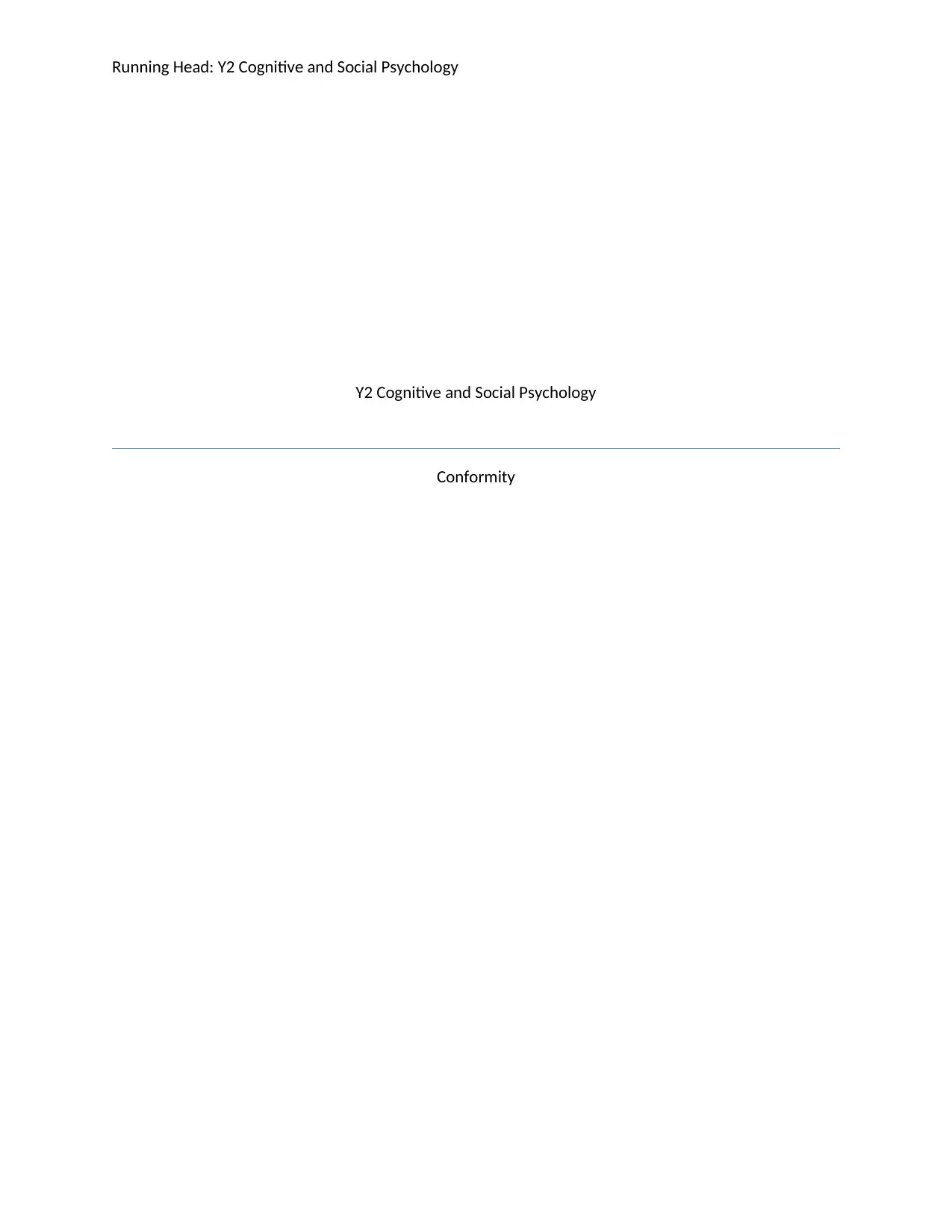
Running Head: Y2 Cognitive and Social Psychology
Y2 Cognitive and Social Psychology
Conformity
Y2 Cognitive and Social Psychology
Conformity
Paraphrase This Document
Need a fresh take? Get an instant paraphrase of this document with our AI Paraphraser
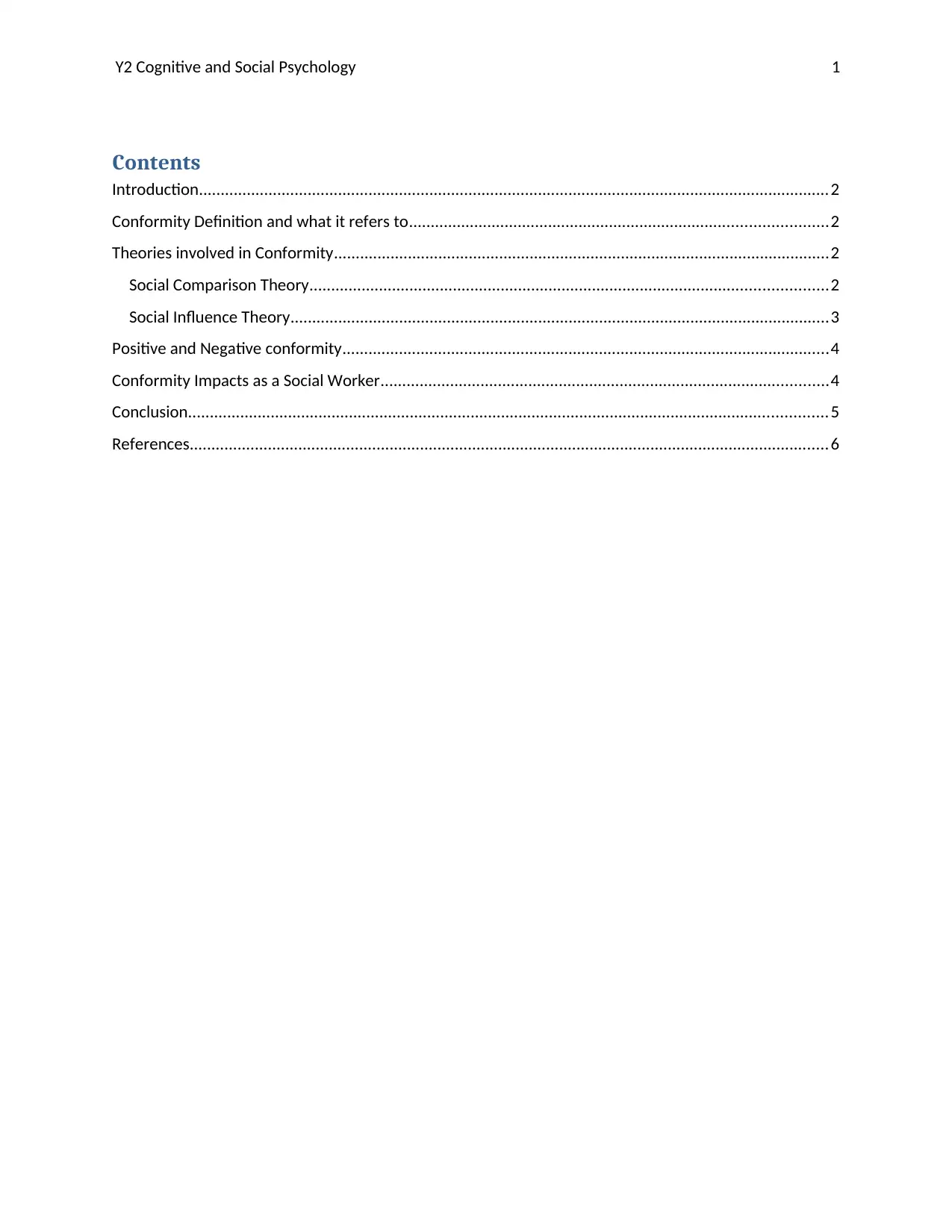
Y2 Cognitive and Social Psychology 1
Contents
Introduction.................................................................................................................................................2
Conformity Definition and what it refers to................................................................................................2
Theories involved in Conformity..................................................................................................................2
Social Comparison Theory.......................................................................................................................2
Social Influence Theory............................................................................................................................3
Positive and Negative conformity................................................................................................................4
Conformity Impacts as a Social Worker.......................................................................................................4
Conclusion...................................................................................................................................................5
References...................................................................................................................................................6
Contents
Introduction.................................................................................................................................................2
Conformity Definition and what it refers to................................................................................................2
Theories involved in Conformity..................................................................................................................2
Social Comparison Theory.......................................................................................................................2
Social Influence Theory............................................................................................................................3
Positive and Negative conformity................................................................................................................4
Conformity Impacts as a Social Worker.......................................................................................................4
Conclusion...................................................................................................................................................5
References...................................................................................................................................................6

Y2 Cognitive and Social Psychology 2
Introduction
Conformity is the kind of an act which is related to changing of the behavior just to match with
the responses of others. A few hundred years ago, Deutsch & Gerard, differentiated in between
the two: informational and normal conformity. The first was based on the wish to form the exact
interpretation of the reality and the behavior. And the second one was based on the goals to
obtain approval socially from others (Cialdini & Goldstein, 2004). Conformity is generally taken
as a criticized feature of the human belief formation. It is also considered as the negative
influence over reliability (James, 2008). This report focuses on the definition of the conformity
and its theories that are related to it. Also the analysis of the idea of conformity is done.
Conformity Definition and what it refers to
Conformity is the act in which people will come up with the same behavior as others by
changing attitudes and behaviors. It usually occurs in the small groups or in the society on the
whole. It can either occur in front of others or individually too. The best example of this is
people following social norms while watching TV or even when they are alone. It is generally
associated with the young age people but it may occur in any ages of people (Bernheim & Exley,
2015). The final explanation for it is social influence. People might conform according to others
choices if they fear the society.
Theories involved in Conformity
Social Comparison Theory
Social comparison is the habit for evaluating oneself and comparing to others. This is a
significant source of behavior which is competitive. This theory states that the people who are
driven by the basic drive upward, they improve their performance and at the same time they
reduce discrepancies between them and other people’s level of performance. This act of
Introduction
Conformity is the kind of an act which is related to changing of the behavior just to match with
the responses of others. A few hundred years ago, Deutsch & Gerard, differentiated in between
the two: informational and normal conformity. The first was based on the wish to form the exact
interpretation of the reality and the behavior. And the second one was based on the goals to
obtain approval socially from others (Cialdini & Goldstein, 2004). Conformity is generally taken
as a criticized feature of the human belief formation. It is also considered as the negative
influence over reliability (James, 2008). This report focuses on the definition of the conformity
and its theories that are related to it. Also the analysis of the idea of conformity is done.
Conformity Definition and what it refers to
Conformity is the act in which people will come up with the same behavior as others by
changing attitudes and behaviors. It usually occurs in the small groups or in the society on the
whole. It can either occur in front of others or individually too. The best example of this is
people following social norms while watching TV or even when they are alone. It is generally
associated with the young age people but it may occur in any ages of people (Bernheim & Exley,
2015). The final explanation for it is social influence. People might conform according to others
choices if they fear the society.
Theories involved in Conformity
Social Comparison Theory
Social comparison is the habit for evaluating oneself and comparing to others. This is a
significant source of behavior which is competitive. This theory states that the people who are
driven by the basic drive upward, they improve their performance and at the same time they
reduce discrepancies between them and other people’s level of performance. This act of
⊘ This is a preview!⊘
Do you want full access?
Subscribe today to unlock all pages.

Trusted by 1+ million students worldwide
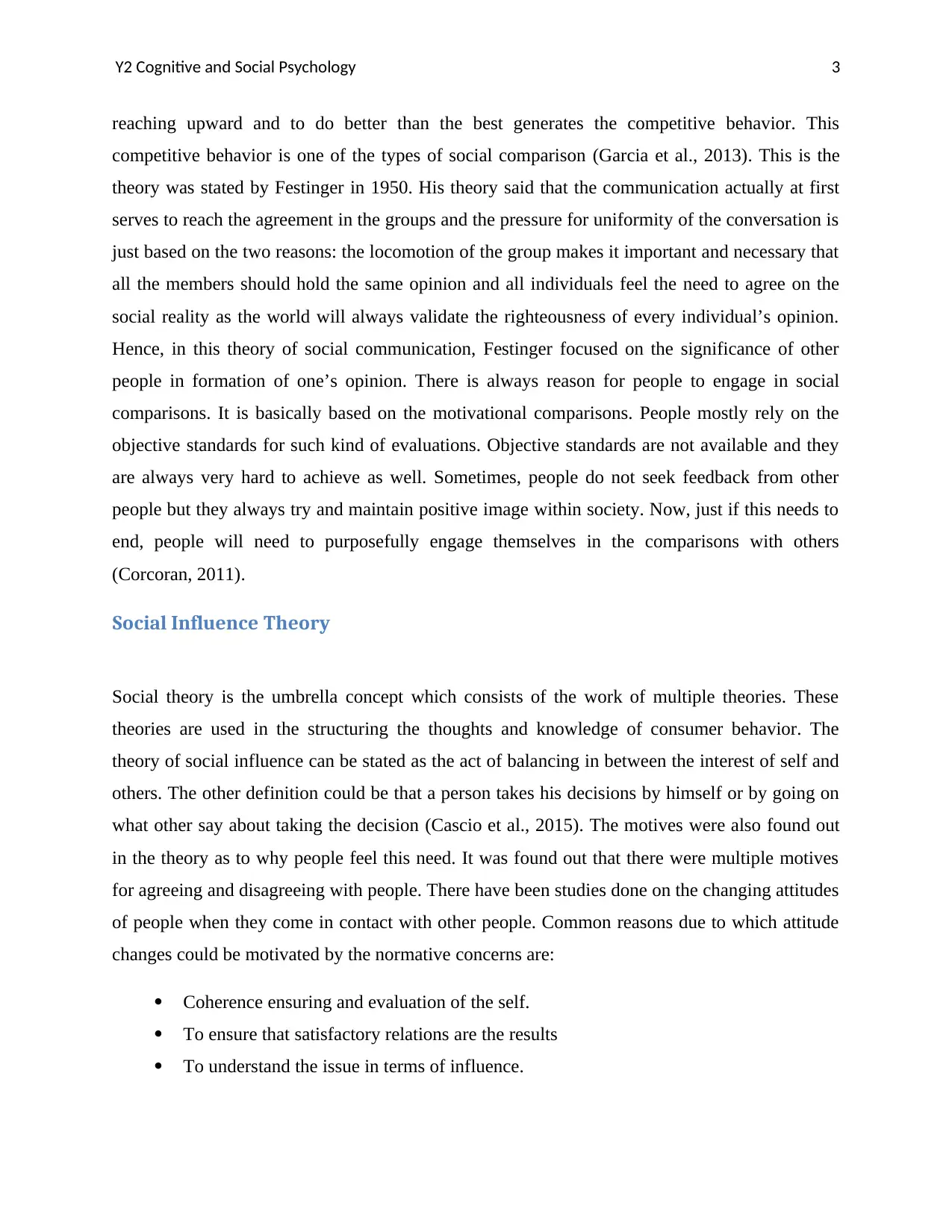
Y2 Cognitive and Social Psychology 3
reaching upward and to do better than the best generates the competitive behavior. This
competitive behavior is one of the types of social comparison (Garcia et al., 2013). This is the
theory was stated by Festinger in 1950. His theory said that the communication actually at first
serves to reach the agreement in the groups and the pressure for uniformity of the conversation is
just based on the two reasons: the locomotion of the group makes it important and necessary that
all the members should hold the same opinion and all individuals feel the need to agree on the
social reality as the world will always validate the righteousness of every individual’s opinion.
Hence, in this theory of social communication, Festinger focused on the significance of other
people in formation of one’s opinion. There is always reason for people to engage in social
comparisons. It is basically based on the motivational comparisons. People mostly rely on the
objective standards for such kind of evaluations. Objective standards are not available and they
are always very hard to achieve as well. Sometimes, people do not seek feedback from other
people but they always try and maintain positive image within society. Now, just if this needs to
end, people will need to purposefully engage themselves in the comparisons with others
(Corcoran, 2011).
Social Influence Theory
Social theory is the umbrella concept which consists of the work of multiple theories. These
theories are used in the structuring the thoughts and knowledge of consumer behavior. The
theory of social influence can be stated as the act of balancing in between the interest of self and
others. The other definition could be that a person takes his decisions by himself or by going on
what other say about taking the decision (Cascio et al., 2015). The motives were also found out
in the theory as to why people feel this need. It was found out that there were multiple motives
for agreeing and disagreeing with people. There have been studies done on the changing attitudes
of people when they come in contact with other people. Common reasons due to which attitude
changes could be motivated by the normative concerns are:
Coherence ensuring and evaluation of the self.
To ensure that satisfactory relations are the results
To understand the issue in terms of influence.
reaching upward and to do better than the best generates the competitive behavior. This
competitive behavior is one of the types of social comparison (Garcia et al., 2013). This is the
theory was stated by Festinger in 1950. His theory said that the communication actually at first
serves to reach the agreement in the groups and the pressure for uniformity of the conversation is
just based on the two reasons: the locomotion of the group makes it important and necessary that
all the members should hold the same opinion and all individuals feel the need to agree on the
social reality as the world will always validate the righteousness of every individual’s opinion.
Hence, in this theory of social communication, Festinger focused on the significance of other
people in formation of one’s opinion. There is always reason for people to engage in social
comparisons. It is basically based on the motivational comparisons. People mostly rely on the
objective standards for such kind of evaluations. Objective standards are not available and they
are always very hard to achieve as well. Sometimes, people do not seek feedback from other
people but they always try and maintain positive image within society. Now, just if this needs to
end, people will need to purposefully engage themselves in the comparisons with others
(Corcoran, 2011).
Social Influence Theory
Social theory is the umbrella concept which consists of the work of multiple theories. These
theories are used in the structuring the thoughts and knowledge of consumer behavior. The
theory of social influence can be stated as the act of balancing in between the interest of self and
others. The other definition could be that a person takes his decisions by himself or by going on
what other say about taking the decision (Cascio et al., 2015). The motives were also found out
in the theory as to why people feel this need. It was found out that there were multiple motives
for agreeing and disagreeing with people. There have been studies done on the changing attitudes
of people when they come in contact with other people. Common reasons due to which attitude
changes could be motivated by the normative concerns are:
Coherence ensuring and evaluation of the self.
To ensure that satisfactory relations are the results
To understand the issue in terms of influence.
Paraphrase This Document
Need a fresh take? Get an instant paraphrase of this document with our AI Paraphraser
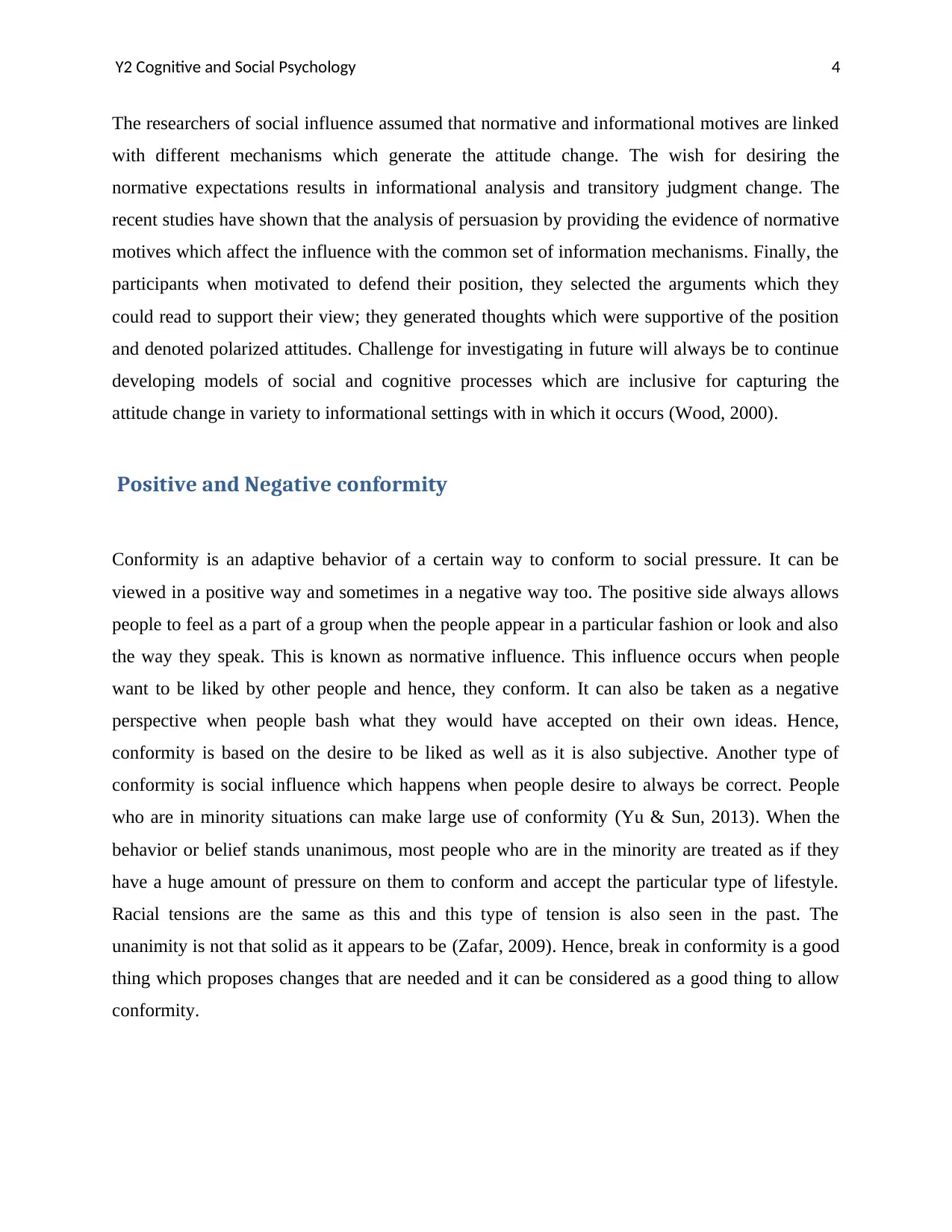
Y2 Cognitive and Social Psychology 4
The researchers of social influence assumed that normative and informational motives are linked
with different mechanisms which generate the attitude change. The wish for desiring the
normative expectations results in informational analysis and transitory judgment change. The
recent studies have shown that the analysis of persuasion by providing the evidence of normative
motives which affect the influence with the common set of information mechanisms. Finally, the
participants when motivated to defend their position, they selected the arguments which they
could read to support their view; they generated thoughts which were supportive of the position
and denoted polarized attitudes. Challenge for investigating in future will always be to continue
developing models of social and cognitive processes which are inclusive for capturing the
attitude change in variety to informational settings with in which it occurs (Wood, 2000).
Positive and Negative conformity
Conformity is an adaptive behavior of a certain way to conform to social pressure. It can be
viewed in a positive way and sometimes in a negative way too. The positive side always allows
people to feel as a part of a group when the people appear in a particular fashion or look and also
the way they speak. This is known as normative influence. This influence occurs when people
want to be liked by other people and hence, they conform. It can also be taken as a negative
perspective when people bash what they would have accepted on their own ideas. Hence,
conformity is based on the desire to be liked as well as it is also subjective. Another type of
conformity is social influence which happens when people desire to always be correct. People
who are in minority situations can make large use of conformity (Yu & Sun, 2013). When the
behavior or belief stands unanimous, most people who are in the minority are treated as if they
have a huge amount of pressure on them to conform and accept the particular type of lifestyle.
Racial tensions are the same as this and this type of tension is also seen in the past. The
unanimity is not that solid as it appears to be (Zafar, 2009). Hence, break in conformity is a good
thing which proposes changes that are needed and it can be considered as a good thing to allow
conformity.
The researchers of social influence assumed that normative and informational motives are linked
with different mechanisms which generate the attitude change. The wish for desiring the
normative expectations results in informational analysis and transitory judgment change. The
recent studies have shown that the analysis of persuasion by providing the evidence of normative
motives which affect the influence with the common set of information mechanisms. Finally, the
participants when motivated to defend their position, they selected the arguments which they
could read to support their view; they generated thoughts which were supportive of the position
and denoted polarized attitudes. Challenge for investigating in future will always be to continue
developing models of social and cognitive processes which are inclusive for capturing the
attitude change in variety to informational settings with in which it occurs (Wood, 2000).
Positive and Negative conformity
Conformity is an adaptive behavior of a certain way to conform to social pressure. It can be
viewed in a positive way and sometimes in a negative way too. The positive side always allows
people to feel as a part of a group when the people appear in a particular fashion or look and also
the way they speak. This is known as normative influence. This influence occurs when people
want to be liked by other people and hence, they conform. It can also be taken as a negative
perspective when people bash what they would have accepted on their own ideas. Hence,
conformity is based on the desire to be liked as well as it is also subjective. Another type of
conformity is social influence which happens when people desire to always be correct. People
who are in minority situations can make large use of conformity (Yu & Sun, 2013). When the
behavior or belief stands unanimous, most people who are in the minority are treated as if they
have a huge amount of pressure on them to conform and accept the particular type of lifestyle.
Racial tensions are the same as this and this type of tension is also seen in the past. The
unanimity is not that solid as it appears to be (Zafar, 2009). Hence, break in conformity is a good
thing which proposes changes that are needed and it can be considered as a good thing to allow
conformity.
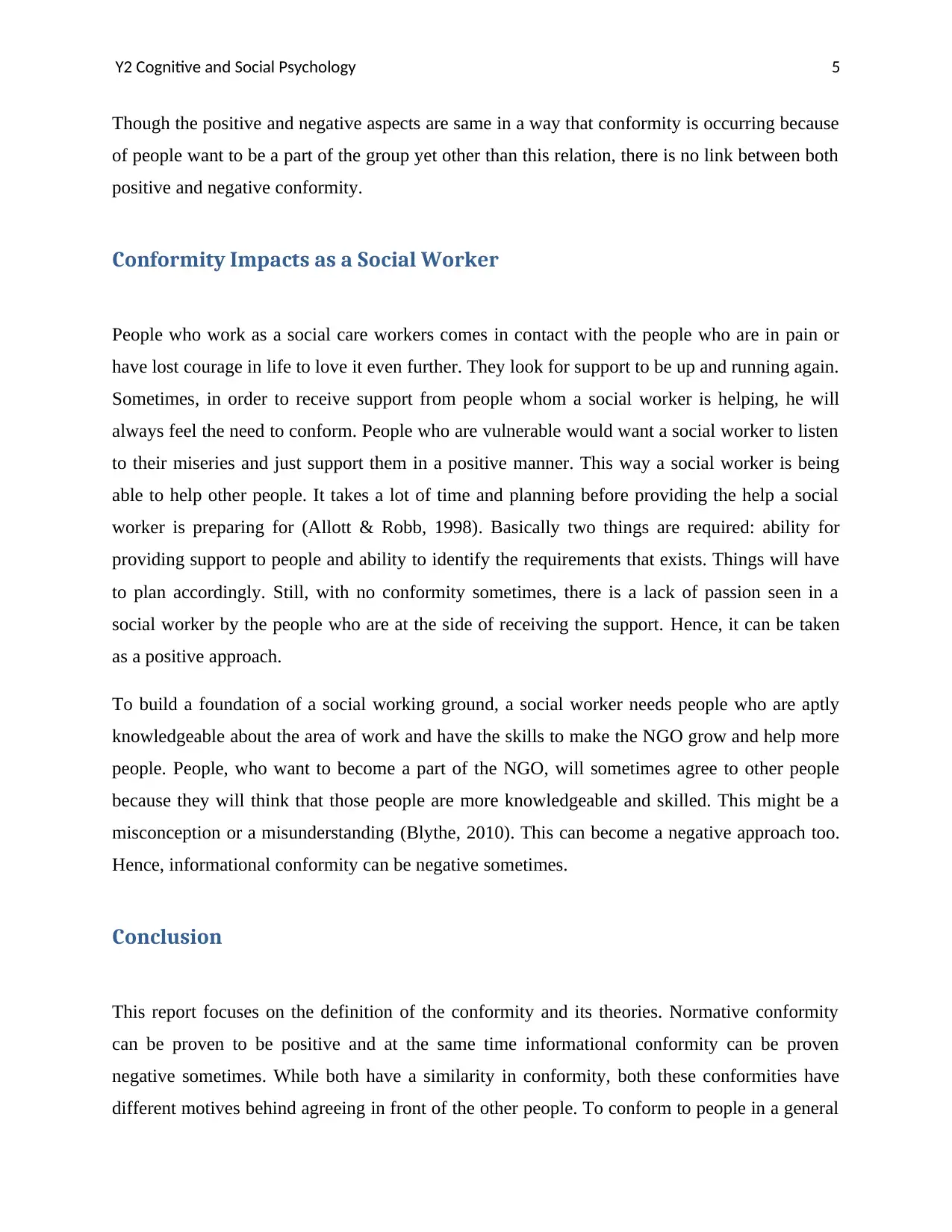
Y2 Cognitive and Social Psychology 5
Though the positive and negative aspects are same in a way that conformity is occurring because
of people want to be a part of the group yet other than this relation, there is no link between both
positive and negative conformity.
Conformity Impacts as a Social Worker
People who work as a social care workers comes in contact with the people who are in pain or
have lost courage in life to love it even further. They look for support to be up and running again.
Sometimes, in order to receive support from people whom a social worker is helping, he will
always feel the need to conform. People who are vulnerable would want a social worker to listen
to their miseries and just support them in a positive manner. This way a social worker is being
able to help other people. It takes a lot of time and planning before providing the help a social
worker is preparing for (Allott & Robb, 1998). Basically two things are required: ability for
providing support to people and ability to identify the requirements that exists. Things will have
to plan accordingly. Still, with no conformity sometimes, there is a lack of passion seen in a
social worker by the people who are at the side of receiving the support. Hence, it can be taken
as a positive approach.
To build a foundation of a social working ground, a social worker needs people who are aptly
knowledgeable about the area of work and have the skills to make the NGO grow and help more
people. People, who want to become a part of the NGO, will sometimes agree to other people
because they will think that those people are more knowledgeable and skilled. This might be a
misconception or a misunderstanding (Blythe, 2010). This can become a negative approach too.
Hence, informational conformity can be negative sometimes.
Conclusion
This report focuses on the definition of the conformity and its theories. Normative conformity
can be proven to be positive and at the same time informational conformity can be proven
negative sometimes. While both have a similarity in conformity, both these conformities have
different motives behind agreeing in front of the other people. To conform to people in a general
Though the positive and negative aspects are same in a way that conformity is occurring because
of people want to be a part of the group yet other than this relation, there is no link between both
positive and negative conformity.
Conformity Impacts as a Social Worker
People who work as a social care workers comes in contact with the people who are in pain or
have lost courage in life to love it even further. They look for support to be up and running again.
Sometimes, in order to receive support from people whom a social worker is helping, he will
always feel the need to conform. People who are vulnerable would want a social worker to listen
to their miseries and just support them in a positive manner. This way a social worker is being
able to help other people. It takes a lot of time and planning before providing the help a social
worker is preparing for (Allott & Robb, 1998). Basically two things are required: ability for
providing support to people and ability to identify the requirements that exists. Things will have
to plan accordingly. Still, with no conformity sometimes, there is a lack of passion seen in a
social worker by the people who are at the side of receiving the support. Hence, it can be taken
as a positive approach.
To build a foundation of a social working ground, a social worker needs people who are aptly
knowledgeable about the area of work and have the skills to make the NGO grow and help more
people. People, who want to become a part of the NGO, will sometimes agree to other people
because they will think that those people are more knowledgeable and skilled. This might be a
misconception or a misunderstanding (Blythe, 2010). This can become a negative approach too.
Hence, informational conformity can be negative sometimes.
Conclusion
This report focuses on the definition of the conformity and its theories. Normative conformity
can be proven to be positive and at the same time informational conformity can be proven
negative sometimes. While both have a similarity in conformity, both these conformities have
different motives behind agreeing in front of the other people. To conform to people in a general
⊘ This is a preview!⊘
Do you want full access?
Subscribe today to unlock all pages.

Trusted by 1+ million students worldwide
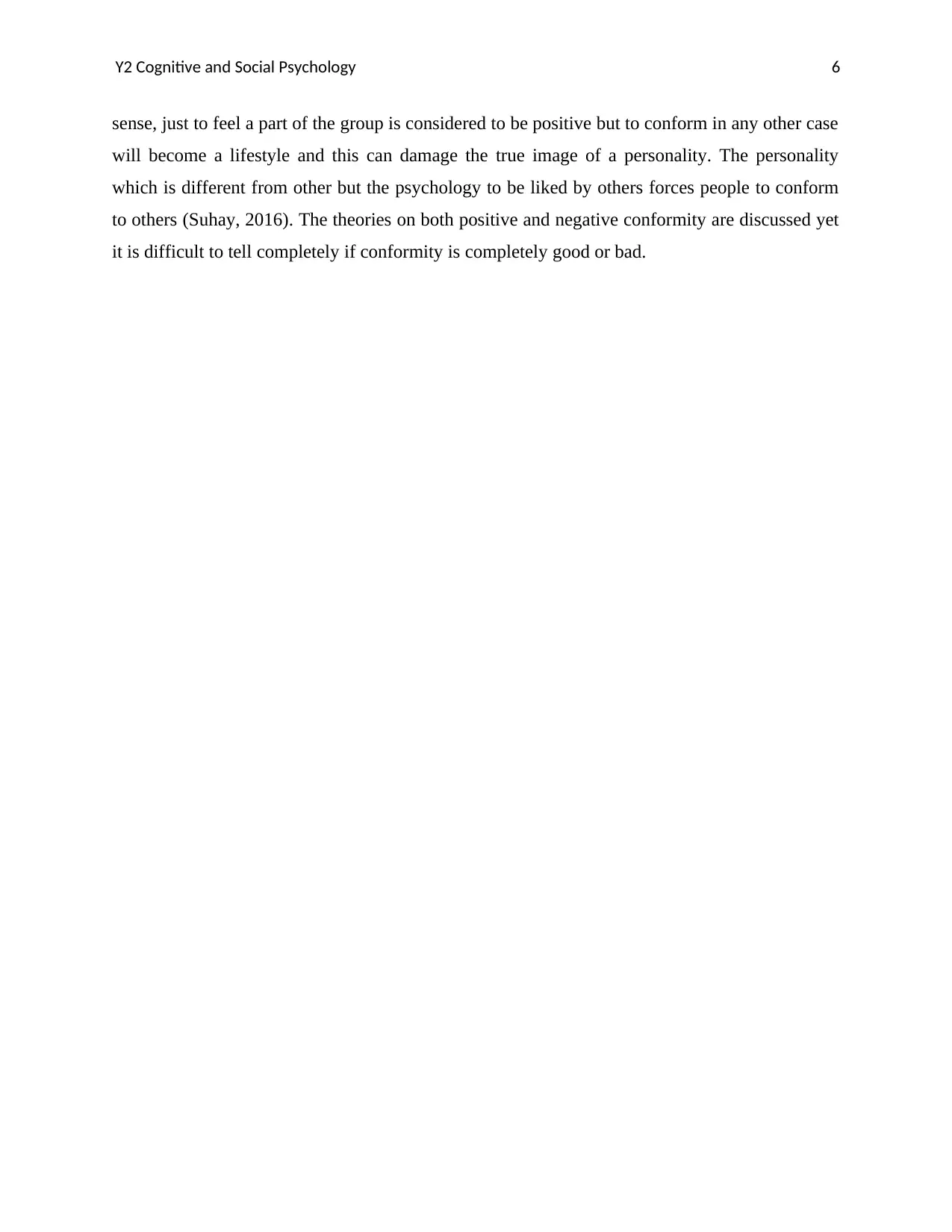
Y2 Cognitive and Social Psychology 6
sense, just to feel a part of the group is considered to be positive but to conform in any other case
will become a lifestyle and this can damage the true image of a personality. The personality
which is different from other but the psychology to be liked by others forces people to conform
to others (Suhay, 2016). The theories on both positive and negative conformity are discussed yet
it is difficult to tell completely if conformity is completely good or bad.
sense, just to feel a part of the group is considered to be positive but to conform in any other case
will become a lifestyle and this can damage the true image of a personality. The personality
which is different from other but the psychology to be liked by others forces people to conform
to others (Suhay, 2016). The theories on both positive and negative conformity are discussed yet
it is difficult to tell completely if conformity is completely good or bad.
Paraphrase This Document
Need a fresh take? Get an instant paraphrase of this document with our AI Paraphraser
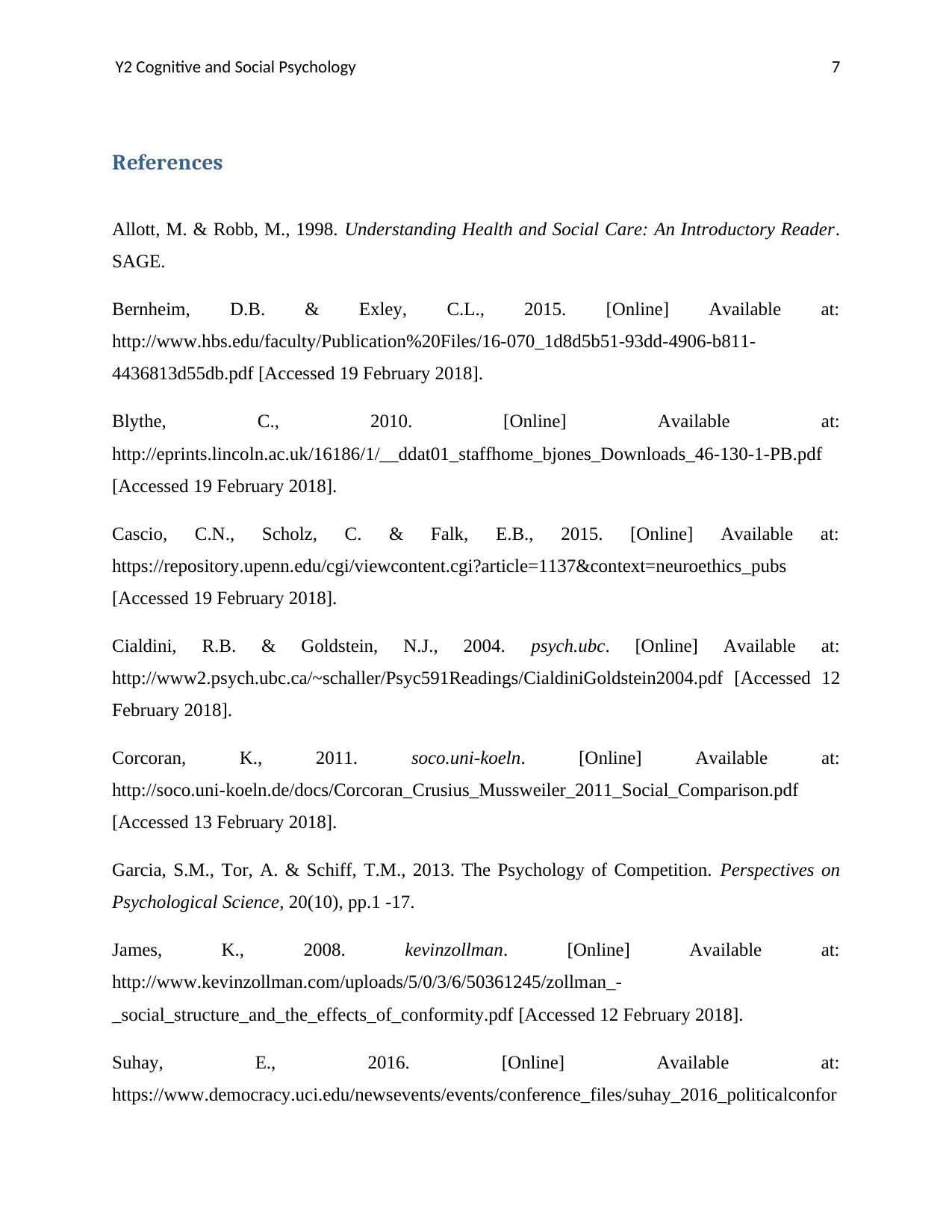
Y2 Cognitive and Social Psychology 7
References
Allott, M. & Robb, M., 1998. Understanding Health and Social Care: An Introductory Reader.
SAGE.
Bernheim, D.B. & Exley, C.L., 2015. [Online] Available at:
http://www.hbs.edu/faculty/Publication%20Files/16-070_1d8d5b51-93dd-4906-b811-
4436813d55db.pdf [Accessed 19 February 2018].
Blythe, C., 2010. [Online] Available at:
http://eprints.lincoln.ac.uk/16186/1/__ddat01_staffhome_bjones_Downloads_46-130-1-PB.pdf
[Accessed 19 February 2018].
Cascio, C.N., Scholz, C. & Falk, E.B., 2015. [Online] Available at:
https://repository.upenn.edu/cgi/viewcontent.cgi?article=1137&context=neuroethics_pubs
[Accessed 19 February 2018].
Cialdini, R.B. & Goldstein, N.J., 2004. psych.ubc. [Online] Available at:
http://www2.psych.ubc.ca/~schaller/Psyc591Readings/CialdiniGoldstein2004.pdf [Accessed 12
February 2018].
Corcoran, K., 2011. soco.uni-koeln. [Online] Available at:
http://soco.uni-koeln.de/docs/Corcoran_Crusius_Mussweiler_2011_Social_Comparison.pdf
[Accessed 13 February 2018].
Garcia, S.M., Tor, A. & Schiff, T.M., 2013. The Psychology of Competition. Perspectives on
Psychological Science, 20(10), pp.1 -17.
James, K., 2008. kevinzollman. [Online] Available at:
http://www.kevinzollman.com/uploads/5/0/3/6/50361245/zollman_-
_social_structure_and_the_effects_of_conformity.pdf [Accessed 12 February 2018].
Suhay, E., 2016. [Online] Available at:
https://www.democracy.uci.edu/newsevents/events/conference_files/suhay_2016_politicalconfor
References
Allott, M. & Robb, M., 1998. Understanding Health and Social Care: An Introductory Reader.
SAGE.
Bernheim, D.B. & Exley, C.L., 2015. [Online] Available at:
http://www.hbs.edu/faculty/Publication%20Files/16-070_1d8d5b51-93dd-4906-b811-
4436813d55db.pdf [Accessed 19 February 2018].
Blythe, C., 2010. [Online] Available at:
http://eprints.lincoln.ac.uk/16186/1/__ddat01_staffhome_bjones_Downloads_46-130-1-PB.pdf
[Accessed 19 February 2018].
Cascio, C.N., Scholz, C. & Falk, E.B., 2015. [Online] Available at:
https://repository.upenn.edu/cgi/viewcontent.cgi?article=1137&context=neuroethics_pubs
[Accessed 19 February 2018].
Cialdini, R.B. & Goldstein, N.J., 2004. psych.ubc. [Online] Available at:
http://www2.psych.ubc.ca/~schaller/Psyc591Readings/CialdiniGoldstein2004.pdf [Accessed 12
February 2018].
Corcoran, K., 2011. soco.uni-koeln. [Online] Available at:
http://soco.uni-koeln.de/docs/Corcoran_Crusius_Mussweiler_2011_Social_Comparison.pdf
[Accessed 13 February 2018].
Garcia, S.M., Tor, A. & Schiff, T.M., 2013. The Psychology of Competition. Perspectives on
Psychological Science, 20(10), pp.1 -17.
James, K., 2008. kevinzollman. [Online] Available at:
http://www.kevinzollman.com/uploads/5/0/3/6/50361245/zollman_-
_social_structure_and_the_effects_of_conformity.pdf [Accessed 12 February 2018].
Suhay, E., 2016. [Online] Available at:
https://www.democracy.uci.edu/newsevents/events/conference_files/suhay_2016_politicalconfor
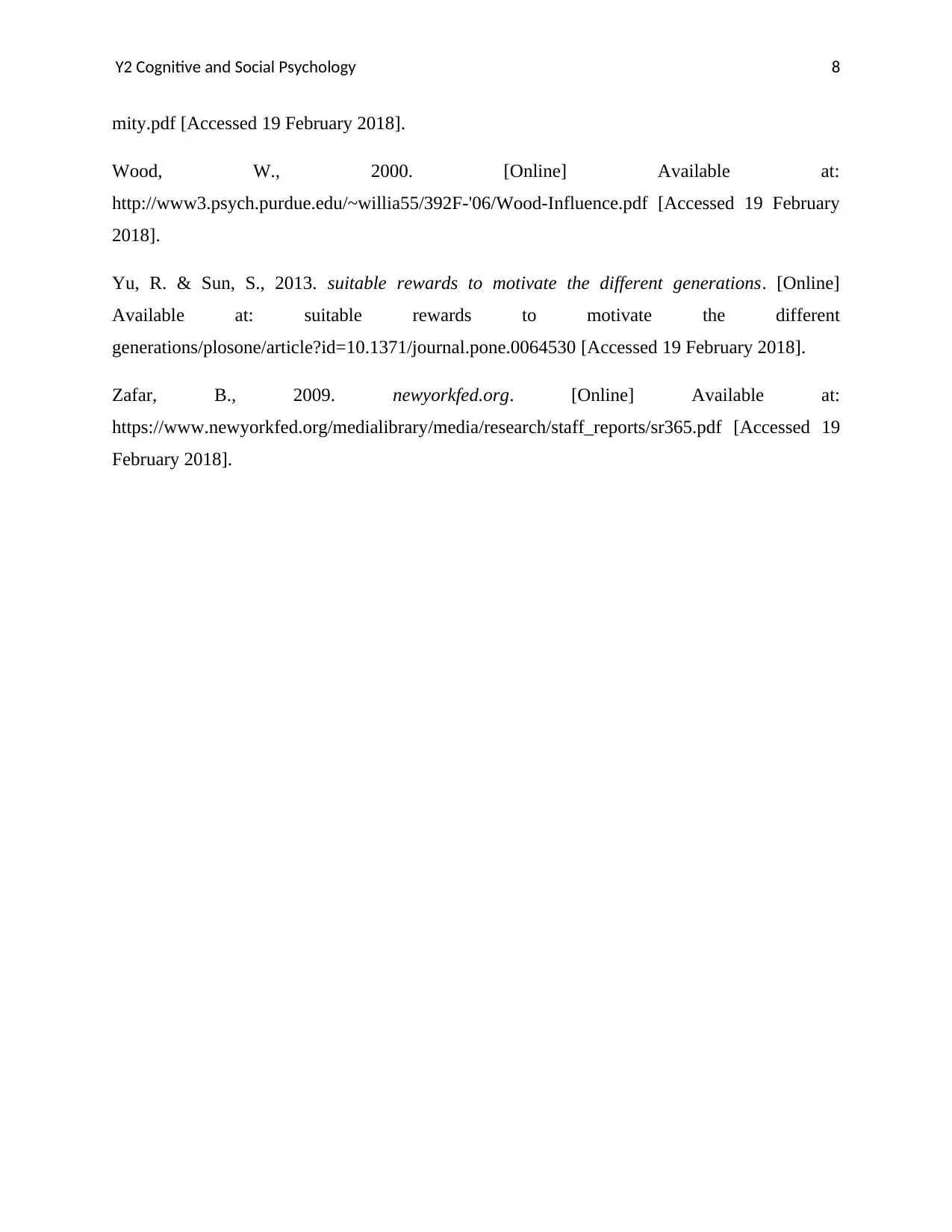
Y2 Cognitive and Social Psychology 8
mity.pdf [Accessed 19 February 2018].
Wood, W., 2000. [Online] Available at:
http://www3.psych.purdue.edu/~willia55/392F-'06/Wood-Influence.pdf [Accessed 19 February
2018].
Yu, R. & Sun, S., 2013. suitable rewards to motivate the different generations. [Online]
Available at: suitable rewards to motivate the different
generations/plosone/article?id=10.1371/journal.pone.0064530 [Accessed 19 February 2018].
Zafar, B., 2009. newyorkfed.org. [Online] Available at:
https://www.newyorkfed.org/medialibrary/media/research/staff_reports/sr365.pdf [Accessed 19
February 2018].
mity.pdf [Accessed 19 February 2018].
Wood, W., 2000. [Online] Available at:
http://www3.psych.purdue.edu/~willia55/392F-'06/Wood-Influence.pdf [Accessed 19 February
2018].
Yu, R. & Sun, S., 2013. suitable rewards to motivate the different generations. [Online]
Available at: suitable rewards to motivate the different
generations/plosone/article?id=10.1371/journal.pone.0064530 [Accessed 19 February 2018].
Zafar, B., 2009. newyorkfed.org. [Online] Available at:
https://www.newyorkfed.org/medialibrary/media/research/staff_reports/sr365.pdf [Accessed 19
February 2018].
⊘ This is a preview!⊘
Do you want full access?
Subscribe today to unlock all pages.

Trusted by 1+ million students worldwide
1 out of 9
Related Documents
Your All-in-One AI-Powered Toolkit for Academic Success.
+13062052269
info@desklib.com
Available 24*7 on WhatsApp / Email
![[object Object]](/_next/static/media/star-bottom.7253800d.svg)
Unlock your academic potential
Copyright © 2020–2025 A2Z Services. All Rights Reserved. Developed and managed by ZUCOL.





